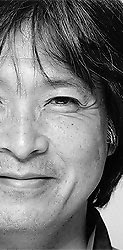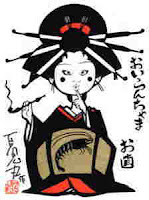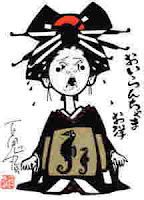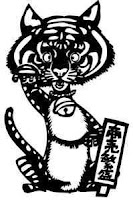 |
| Hyakkimaru |
Japanese artist, and Colorado Springs “sibling” if you will, Hyakkimaru will exhibit his masterful “kirie” paper cuttings at the Fine Arts Center this Saturday. The show entitled, Hyakkimaru’s Kirie World, is part of a 50th anniversary celebration of Fujiyoshida, the artist’s hometown, and our own Colorado Springs becoming sister cities. Hyakkimaru could not be more thrilled to be involved.
When asked what he is looking forward to most in the days to come, Hyakkimaru responded without hesitation – “Entertainment! My art is lively like you, I want you to come enjoy my Kirie”. And enjoy it you will – how could you not? Hyakkimaru’s show buzzes with life; his paper cuttings depict sword bearing Samurai standing so tall you can look them in the eye and his live performances are sure to send jaws dropping to the floor. Come Saturday to the FAC’s Glass Corridor at 11 a.m. and 1 p.m. (free!) and you can request a subject to be cut by Hyakkimaru live – your vision will materialize in a matter of minutes as the artist sketches, snips, and slices at an awe-inspiring speed.
I was lucky to speak with Hyakkimaru and get a sneak peek of his work while he prepared for the upcoming show and I can guarantee, Hyakkimaru will succeed in his efforts to entertain. Below is an excerpt of our chat:
FAC: This weekend you will be exhibiting your unique “kirie” style paper cuttings at the Colorado Springs Fine Arts Center as well as demonstrating your artistic process live. Would you describe the kirie art form and tell me a bit about its history?
Hyakkimaru: Kirie is the ancient Japanese art form of paper cutting. It originated long ago in the Shinto Shrine. Artists would use paper and knives to make symbols of spiritual animals such as the turtle and dedicate their work to the gods. Kirie was then lost for a very long time; only recently did it resurface and begin to be recognized again in Japan.
FAC: Would you tell me a bit about your personal journey as a kirie artist?
Hyakkimaru: Certainly. After graduating from college with a degree in architecture I decided very quickly that I did not have enough talent to make it as an architect. Looking back on this decision with greater maturity, I see it is more likely I just did not have enough confidence – I was thinking too much as a young student and I quit very early on in my career.
But in the end, my choice was a very good one. I feel that the meaning of life is just to be happy, so after I quit architecture I began to search for some type of work where I could feel the meaning every day. I knew I wanted to do something with my hands – to really create something. I began doing pottery.
Of course as a young man I felt that I did not have enough talent for pottery either. When I began working with clay at 25, I knew that there were people my age who were already expert professors while I was just learning. I looked back on a lesson I had learned only a few years prior. In college I started to play tennis and I wanted to be very good so I studied it very hard, and I improved so much, so quickly. I applied this approach to art and again I progressed so fast!
To set my work apart from that of other Japanese artists, I thought deeply about how to make something very different. I printed clay with woodcarvings like a block print and for a while; I thought that was really cool. But I soon realized I did not love pottery. I still wanted to become successful in something that could make me truly happy.
So I began to think, I have always had a mind full of ideas. One day I began putting them on paper, drawing tirelessly to give form to thoughts. I realized I should use these ideas for my art – I started to cut away at my paper drawings with an Exacto knife and I thought the final product looked remarkably good. At that time I was also the manager of a modeling company; I had the professional experience to easily get my work into publishing world.
FAC: I understand you take requests from visitors when creating kirie images live. Once you were asked to create an image of a man’s mother, which you call “Female Farmer”, and the visitor who requested the piece was so touched by the finished product he wept. How does it feel to create artwork that is so personally moving for your visitors?

Hyakkimaru: I am always shocked when people have such a powerful reaction to my work. Although it was never my intention to elicit such emotional responses in my viewers, I have found time and time again that there is something unique about my work that people can connect with in a very profound way. I hope that you will feel this too at my upcoming show. Another powerful example of an emotional connection is when I was doing a live kirie performance but no one made requests. I decided to do a portrait of a Buddhist symbol that came into my mind. It was an image of a mother and child and one woman in the audience right in front started to cry so much. She asked me, “Hyakkimaru, can I buy this piece?” and told me she had just recently lost a child.
It is amazing that what I do can be so moving for other people. It is always a wonderful moment.
FAC: Do you ever draw on your own personal experience when creating your work?
Hyakkimaru: My artwork is a product of the way I have always looked at art. Growing up I would walk through Japanese museums and would leave wondering “what was that?”; what I saw really didn’t mean anything to me. Later in life when looking at Picasso, Cézanne, and Pissarro, I still see that average people off of the street feel as I did – they see that the painting is nice, even beautiful, but without knowing art history it is very hard to be excited. When I was becoming an artist I wanted to make sure that my spectators were entertained. I believe art should fun, appealing, energetic and entertaining. When I create, I need a reaction – happy or sad, but never just “OK”, never boring.
FAC: The exhibition will include a kirie warrior collection featuring Native American figures. What about the Native American people has compelled you to include them in your work?
Hyakkimaru: As an artist, and as a person, we all go through life’s struggles. Going through college I felt that my life was not normal – I felt I had so many hardships. This made me attracted to all human struggles. I know the Native American people struggled for many years and I see a strong connection between their struggle and those of my people. Native Americans, like Japanese Samurai warriors, had to fight with others who wanted to take resources from them. They were driven to fight bloody wars and experience extreme grief. I do not believe war is beautiful, but it is appealing to me because it is a form of true humanity. I want to portray this very real struggle.
At the same time I do not just want to show struggle, I want to make something that is appealing for the audience. It is difficult to show the pain that people have to go through in life, but at the same time be beautiful. It is important to understand it was never my intention to make people feel pain when they view my work. I want them to feel only the invigorating nature of humanity that comes from struggle. As I have said before, I hope my work is only beautiful and exciting.
FAC: This year marks the 50th anniversary of your hometown, Fujiyoshida, and Colorado Springs becoming sister cities. How do you feel about representing Fujiyoshida for the celebration here in Colorado Springs?
Hyakkimaru: Our coming together is very special. I was born in 1951, the year my city was officially founded; I think this may be something meaningful and I am glad I can be here for the celebration with other leaders from Fujiyoshida. I love my town very much and I want only great things for my people. I hope that our connection and my visit here can help us become more prosperous like Colorado Springs. When I arrived last week I was shocked by how lively your city is. The energy is high and this is something I enjoy it very much. I hope that one day my city can be like this.
FAC: With the FAC exhibition fast approaching, what aspects of Japanese art are you most excited about bringing to us here in Colorado Springs?
Hyakkimaru: Entertainment! My art is lively like you, I want you to come enjoy my kirie! Art should be simply fun, I want you to see it does not need to be so serious – all studies and perfection. I have three unique elements of my work that I think make my Kirie appealing for all audiences. First, I have live performance (this part is my favorite, I really enjoy interacting with people). Second, my kirie can be very big; I think people are surprised to see life size figures. And third, I have 3D paper cuttings that are quite unique.
“I am excited to share this all with you. I hope you will be stunned and become excited by the possibilities of kirie”.
Hyakkimaru’s Kirie World
On view July 28–Sept. 15, 2012
July 28, 2012 | Exhibition Opening
To celebrate the opening of this exhibition, artist Hyakkimaru will demonstrate his artistic process of creating kirie — the traditional Japanese art form of paper cutting. FAC’s Glass Corridor, 11 a.m., 1 p.m., FREE.
Aug. 4, 2012 | Mountain Festival
Celebrating 50 years, the Mountain Festival features diverse performances and cultural activities, including a demonstration by the artist Hyakkimaru. America the Beautiful Park, 12-8 p.m., FREE.
Aug. 18, 2012 | Family Adventure Day
Artist Hyakkimaru demonstrates his process of creating kirie at Family Adventure Day: 10:30 am; 11:30 a.m.; 12:30 p.m., FREE.
Aug. 25, 2012 | Kirie Workshop
Artist Hyakkimaru guides participants through the process of making kirie in this two-hour workshop. Create kirie works based on your own drawings. Bemis School of Art, 10 a.m. – 12 p.m., $27 for Members, $30 for non-members.
Aug. 28, 2012 | Kirie Workshop
Artist Hyakkimaru guides participants through the process of making kirie in this two-hour workshop. Create kirie works based on your own drawings. Bemis School of Art, 4:30-6:30 p.m., $27 for Members, $30 for non-members.






